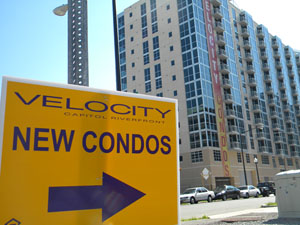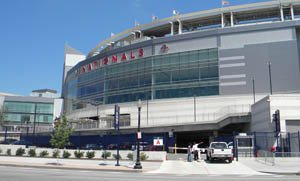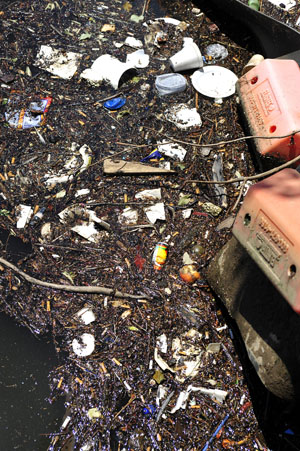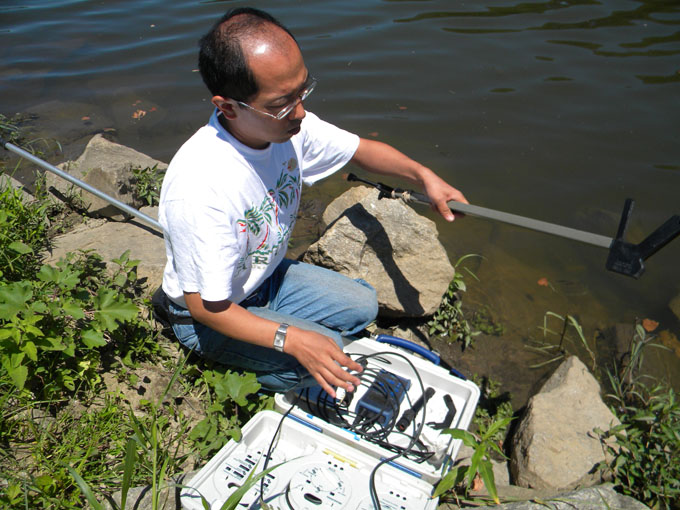Justin Karp
News21 Staff

Condominium and apartment towers have risen rapidly in Near Southeast over the past decade, especially since the completion of Nationals Park in 2008. According to the D.C. Office of Planning, the population of the neighborhood has jumped nearly 75 percent in the last two years. (News21 Photo by Justin Karp)
WASHINGTON (Aug. 6, 2010) - Masada Maeda looks out over the Anacostia River from the back of his 15-foot-long skiff. All along the banks and floating through the water are plastic cups, beer cans, Styrofoam and dozens of other types of trash.
“It’s not as bad as it used to be,” says Maeda, who in his work for the nonprofit Anacostia Watershed Society has been sampling the river water since 2002.
The 8.6-mile river – one of the most polluted tributaries of the Chesapeake Bay -- is becoming more “visually presentable,” Maeda says, in part because of a major trash-removal program ramping up this year. The District on Jan. 1 put in place a 5-cent fee on plastic bags given out at stores selling groceries that devotes most of its funds to removing trash from the Anacostia. This year, the jurisdictions surrounding the Anacostia drafted a plan that calls for them to remove more than a thousand pounds of trash from the river and its tributaries every day.
Clearing the trash from the river is one step of a multi-jurisdictional, federally mandated effort to restore it – an effort that includes overhauling an antiquated sewage and storm water system. The goal is to eventually make the river fishable and swimmable.
Cleanup efforts have helped lure development to the waterfront—including Nationals Park, which opened in 2008 for the home baseball team -- and planned residences and retail space that will sit on the river’s shore. That development, in turn, is helping to spur more cleanup, officials say.
“People choose this area because they know the river is going to be cleaned up and see it as a tremendous asset,” says Michael Stevens, executive director of the Capitol Riverfront Business Improvement District. The improvement district, created by city government in 2007, oversees the development and marketing for more than 60 completed and future projects within the Near Southeast neighborhood along the river, including a Courtyard by Marriott hotel.
The improvements come after decades of degradation of the Anacostia, caused by development in its watershed -- the 176-square-mile area of land and tributaries that extend into Montgomery and Prince George’s counties in Maryland. The river has been plagued by raw sewage overflows during heavy rains, and oil and grease and other toxic runoff from city streets and parking lots.
“Most of the areas were developed without management, and now we have to go back and retrofit to bring it up to codes,” says Ken Yetman, the stream corridor assessor for the Maryland Department of Natural Resources.
The region’s two major sewer utilities, D.C. Water and the Washington Suburban Sanitary Commission, are pumping almost $3 billion
into projects mandated by the District to curtail sewage overflows, including an eight-mile-long tunnel under the Anacostia to capture runoff that would normally go straight into the river. Renovations to the Blue Plains Wastewater Treatment Plant are expected to be completed by 2014, but raw sewage overflows into the river during heavy rains could continue for a few years after that, officials say.
(See blog post.)
Federal and local governments are contributing to the river’s cleanup, with grants, taxes and fees going directly to the decades-long restoration effort. Environmental groups have long been active here, successfully suing city agencies more than once to improve the water quality.
“We’re still not sure if this river is getting cleaner or worse,” Maeda says of the water quality, as he dips a plastic sampling bottle into the river near Nationals Park in Southeast Washington. “Aesthetically, though, this river is clearly getting better.”
As he marks his bottle with a black Sharpie, an empty Coca-Cola bottle floats by.
A New City on the River
 Much of the redevelopment of Near Southeast centers around Nationals Park. (News21 photo by Justin Karp)
Much of the redevelopment of Near Southeast centers around Nationals Park. (News21 photo by Justin Karp)
In a conference room on the 11th floor of a New Jersey Avenue high-rise two blocks north of the Anacostia, sitting near a large-scale model of Near Southeast, Stevens exudes optimism.
“We think this is a once-in-a-generation opportunity to build a brand new city on the river,” he says, of the Near Southeast community roughly bounded by South Capitol Street, Interstate-395 and I Street.
Much of the redevelopment of Near Southeast centers around the area’s primary tenant – the Washington Nationals – which moved into its new home across the street from the Anacostia in 2008.
Since the completion of Nationals Park, the area has seen a boomlet in development and investment. The population of the area –which had dropped by nearly 5,000 residents between 1950 and 2008, to 1,830 people, according to Census data – has suddenly begun to climb. It jumped nearly 73 percent, to 3,164, between 2008 and the second quarter of 2010, according to the D.C. Office of Planning.
In that short time, new grocery and drug stores, restaurants, condominium and apartment buildings and millions of feet of office space have all opened in the neighborhood. About 35,000 people now work there, Stevens says.
“This is a happening place to be,” says Gregory McCarthy, the Nationals’ vice president for government affairs. “If you look at the demographic of people who are coming, they are, by and large, a young, green crowd that appreciates this kind of stuff.”
Claire Schaefer, deputy executive director of Capitol Riverfront, says the ballpark brings 2 million people a year to a neighborhood they may never otherwise have visited.
“Part of wanting to bring people down here is to reintroduce them to the river,” Schaefer says. “D.C. has a lot of river frontage but, for so long, you weren’t able to access it.
“What the ballpark did was allow people to come down and see the Anacostia; maybe dip their toe in it. Once they start to care more, then you have a larger base of people that want to clean up the river.”
According to the Capitol Riverfront’s second quarter projections released in July, the neighborhood has already seen $2.3 billion worth of development since 2000, with another $6 billion either under construction or planned for the future.
Akridge, a Washington-based real estate firm, has heavily invested in the area, specifically along the Half Street corridor that leads from the Navy Yard Metro station to Nationals Park. A new 196-room hotel, 50,000 square feet of retail space, 340 residential units, restaurants and bars are all part of the firm’s plan for Half Street.
“I think what you’re seeing is a belief that the river is and will become more and more of an asset to the neighborhood,” says David Tuchmann, a development manager for Akridge.
Having the river become an asset – but not necessarily a developed one – is something environmentalists have long fought for. Jim Dougherty, the conservation chair for the D.C. chapter of the Sierra Club, has been active in other efforts to prevent construction projects along the river, including a proposed theme park on Kingman Island and a proposed extension of I-395 over the river.
“The Anacostia is a poster child for environmental injustice,” Dougherty says. “Whenever the District wants to build a project, they put it there.
“You look at the Potomac and what do you see: the Lincoln Memorial, the Jefferson Memorial and wild, green open space. But on the Anacostia, you have an eyesore like the Benning Road power plant.”
Anacostia Watershed Society leaders say since no more development isn’t a realistic option, planned development is better than much of what came before.
"The fact is this is an urban river, and much of the area is already developed," says Brent Bolin, director of advocacy for the Anacostia Watershed Society.
“Unless we are talking about tearing up Southeast and Southwest D.C. and reestablishing hundreds of acres of wetlands, we're not going back to the original ecosystem."
A Pollution Diet
 The proposed trash removal mandate will require the removal of more than 1.2 million pounds of trash a year from the Anacostia. (News21 Photo by Jason Lenhart)
The proposed trash removal mandate will require the removal of more than 1.2 million pounds of trash a year from the Anacostia. (News21 Photo by Jason Lenhart)
In 2006 and 2008, the D.C. Department of the Environment and the Department of Health declared the Anacostia River impaired by trash. An Anacostia Watershed Society study from June 2008 said the Anacostia contained, on average, 58 pieces of surface trash per 100 feet of river, with some sections of the river containing double that amount.
The Maryland Department of the Environment and the D.C. Department of the Environment, with help from the Environmental Protection Agency, took a major step this April to ignite a trash cleanup effort by proposing a plan that would require the removal of solid waste from the river.
Called a total maximum daily load of trash, it is just the second of its kind to be proposed for a river. In 2007, California’s Water Quality Control Board cooperated on a similar mandate from the EPA for the Los Angeles River.
Total maximum daily loads for other types of pollutants, such as bacteria, heavy metals and oil and grease, have been created for waterways throughout the United States. Those mandates establish how much of a pollutant can exist in a body of water, putting it into compliance with Clean Water Act water quality standards.
Gregory Voigt, an EPA coordinator who oversaw the day-to-day development of the Anacostia’s trash limit, says the Clean Water Act does not offer a numerical standard for an acceptable amount of trash – only saying that trash “shall not be present that is objectionable or a nuisance.”
Maximum daily loads for sediment, fecal coliform, oil and grease and heavy metals have all been set for the Anacostia in the past decade. The Anacostia’s daily trash load is different, though. Instead of declaring how much trash can safely enter the river, this one gives the District and Maryland an amount of trash that must be removed from the Anacostia each day.
The proposed language says the District and Montgomery and Prince George’s counties must collectively remove 1,189 pounds of trash a day from the Anacostia and its tributaries. That adds up to more than 1.2 million pounds of garbage a year.
The District and Maryland submitted a draft of their plan to the EPA in April. After a public comment period, Voigt says he expects a final report to be submitted within the next few weeks. The EPA should approve it shortly thereafter.
Also working toward the cleanup goal is the Anacostia Watershed Restoration Partnership, a coalition of government officials, advocacy groups, environmental agencies and business leaders. It announced a $1.7 billion plan in April that includes more than 3,000 proposed projects dealing with storm water management, stream restoration and trash cleanup.
All three municipalities within the Anacostia watershed have either passed, drafted or are working on stringent, new storm water permits that will curtail the amount of solid and bacterial pollution from entering the watershed. The April report says that more than 35 types of trash, including bottles, cans, plastic bags and Styrofoam, make their way to the Anacostia through storm drains throughout the District, Montgomery and Prince George’s counties.
“The solutions will come from upstream,” Bolin says. “Limiting trash from going into the river is how this will get accomplished.”
D.C. Water, the District’s water and sewer utility, maintains two trash-skimming boats that remove garbage from the surface of the river every day, says Carlton Ray, an administrator with D.C. Water.
Voigt says there will be no expiration date for the trash cleanup mandate. “You set an initial target and you monitor to see how effective implementation is,” he says. “If we get to a point where that target is met and we’re still not happy with the quality of the water, we may have to revise it.”
Hamid Karimi, deputy director of the Office of Natural Resources at the District Department of the Environment, says that the cleanup planning has created a constructive, competitive atmosphere between the District and Maryland.
“Montgomery County passed a very progressive permit, and now we want to do them one better,” he says. “Eventually, Prince George’s County will want to do us all better.”
Cracking Down on Plastic Bags
Environmentalists and policy makers who have the Anacostia’s cleanup in their crosshairs say this “pollution diet” is an important first step toward removing millions of pounds of solid waste from the watershed.
To help meet trash-reduction goals, city officials on Jan. 1 enacted a 5-cent fee on plastic bags distributed at stores selling groceris and liquor within the District of Columbia—an attempt to push shoppers to use reusable bags.
Tommy Wells, the Ward 6 representative on the D.C. Council, sponsored the Anacostia River Cleanup Initiative, which imposed the fee. Many of the neighborhoods in Wells’ ward, including Near Southeast, sit on the river.
“It creates a decision for the consumer,” Wells says.
According to the Office of Tax and Revenue, stores in the District distributed 3 million plastic bags in the first quarter of 2010, Wells says -- down from an expectation of 22 million bags that would have been distributed without the fee.
Wells estimates that the fee will raise upward of $3 million in 2010, which will be directed toward Anacostia cleanup efforts.
Before the bag fee was implemented, plastic bags made up nearly 21 percent of the trash in the main stem of the Anacostia, Wells says.
“The bags were something that were free; they had no value, so people felt free to toss them on the ground,” Bolin says. “Now, people can realize that maybe they don’t need these things.”
Building with the Environment in Mind
Stevens’ main selling point to developers who want to build in Near Southeast is the chance to be part of not only a new neighborhood, but one where residents don’t need to own a car and where they can contribute to the Anacostia’s restoration effort.
“We tout that environmental sustainability is part of our community DNA,” Stevens says. “All of our stakeholders are building LEED certified buildings.” LEED, which stands for Leadership in Energy and Environmental Design, is a certification system developed by the U.S. Green Building Council to recognize development and construction done in the most environmentally sound ways possible.
Capitol Riverfront officials say more than 30 of the existing or planned buildings in the neighborhood are LEED certified.
Examples of environmentally sound and low-impact development exist throughout the riverfront area. Nationals Park was the first professional sports venue in North America to be designated as LEED Silver, making it the greenest ballpark in America.
The stadium boasts such features as a green roof, which can capture storm water before it reaches the Anacostia, and onsite storm water filters. Recycled construction material made up 20 percent of the total structure.
Just east of Nationals Park, The Yards is charging toward a 2014 completion date. “Nobody had a really good reason to come to Near Southeast for the last 25 years unless you worked at the Navy Yard,” says Gary McManus, the marketing director for Forest City Washington, The Yards’ developer.
Upon completion, The Yards, which will front directly onto the Anacostia, will boast a riverfront park, 2,800 residential units, nearly 1.8 million square feet of office space and 400,000 square feet of shopping and dining. The project is part of a Green Building Council program that recognizes exceptional environmental design on a neighborhood level.
The first stage of The Yards, the waterfront park, will open in September. McManus says a plan to build a marina to allow for more interaction with the river is in the works as well.
With all of new development, though, comes the danger of setting back the restoration efforts of the nearby river.
“This is a massive test,” says Dana Minerva, executive director of the Anacostia Watershed Restoration Partnership. “There are some developers who would say that if it costs a dime more, we’re going to oppose it.
“And there are some developers saying, as some recently have, ‘Show us that it’s practicable and we can do it, because we like our rivers to be clean just as everyone else does.’ ”
Bolin is quick to laud the efforts of developers and organizations like Capitol Riverfront for their attentiveness to the restoration effort. “So much of the current development was built without any controls at all,” he says. To do new projects that replace previous development – with new state-of-the-art controls – is a huge plus.”
McManus encourages critics to think about the long-term benefits of low-impact development along the Anacostia. The Yards sits on 42 acres, portions of which formerly contained Washington Navy Yard facilities, which for decades inserted heavy manufacturing right next to the Anacostia.
“The new use is significantly less impactful than what it has been used for over the past 150 years,” McManus says. “If you’ve got an urban area and you have a choice between a heavy industrial use and more of a mixed use with residential and retail space, the latter has a significantly smaller impact.”
Chris Weiss, director of the D.C. Environmental Network, says LEED certification helps, but could be better. It is weak on storm water controls, he says.
Weiss also remains frustrated that so much city money – more than $600 million - was spent on the ballpark. “I wasn’t against baseball,” Weiss says. “I think we needed that money for other public purposes, other environmental programs.”
Transforming the River – Again
On his skiff under the 11th Street Bridges near Southeast Washington, Maeda lowers a plastic black-and-white disc attached to a white rope into the water. He unwinds the rope until he can no longer see the disc.
“In the 1600s, when Captain John Smith sailed up the Anacostia, he found very clean water that was full of fish,” he says. “You were able to see deep down into the river.”
Now, Maeda says that dissolved oxygen levels in some areas of the river can dip low enough - to around 0.2 milliliters of oxygen per liter of water - to cause widespread fish kills.
But Maeda remains hopeful of the river’s recovery. The fact that developers are actively contributing to the restoration of the Anacostia, Karimi says, is encouraging.
Tuchmann admits that selling a long-term view to potential tenants and residents is difficult when tangible results may still be years off.
But, he said, “Real estate interests do tend to take the long-term view, and we look at this neighborhood as one in the early stages of a 20-year expansion.”
The prospect of a sustainable community next to a restored river is one of the many things that drive advocates like Bolin.
“There’s been a real renaissance in the area of Nationals Park and the Navy Yard,” he says. “Twenty years ago, they wouldn’t have built the ballpark where it is on the river.”
But now, he says, “People outside of the environmental community are really buying into a future where the Anacostia River is an amenity to the community.”
And for Maeda, there’s beauty beyond the trash.
“There’s great potential here for recreation in our mind and in everyone’s mind,” he says. “People need to know there are positive things happening here.”
Slide show: Masada Maeda of the Anacostia Watershed Society takes water quality samples on the river.


 Much of the redevelopment of Near Southeast centers around Nationals Park. (News21 photo by Justin Karp)
Much of the redevelopment of Near Southeast centers around Nationals Park. (News21 photo by Justin Karp) The proposed trash removal mandate will require the removal of more than 1.2 million pounds of trash a year from the Anacostia. (News21 Photo by Jason Lenhart)
The proposed trash removal mandate will require the removal of more than 1.2 million pounds of trash a year from the Anacostia. (News21 Photo by Jason Lenhart) 